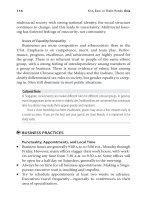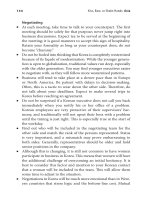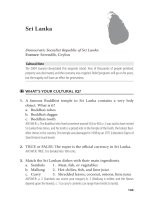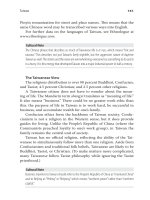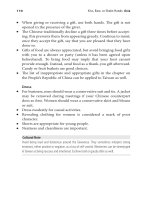How to Understand Business Finance Understand the Business Cycle Manage Your Assets Measure Business Performance Sunday Times Creating Success_5 potx
Bạn đang xem bản rút gọn của tài liệu. Xem và tải ngay bản đầy đủ của tài liệu tại đây (183.66 KB, 18 trang )
80 How to Understand Business Finance
correct specifi cation and have it delivered on time. The bank
looking at this scenario can make reasonable and safe
judgements on their forecasts because they will be backed
by confi rmed purchase orders.
Categories of fi nance
a) Working Capital: This is to fi nance stock/raw material
purchases or to provide the fi nance to allow customers to take
extended credit ie to fi nance debtors. It is a revolving short-
term facility over an agreed period of less than 12 months.
– Overdraft: where the bank allows your current account to
‘go into negative’ but would expect fl uctuations between
debit (overdrawn) and credit on a regular basis. The most
fl exible form of fi nance as little control is exercised by the
bank – it can be used as is seen fi t by the business. Interest
is payable as well as an annual fee.
– Invoice Discounting: this is the borrowing of money against
invoices or debtors that are due. Usually between 60 per
cent and 80 per cent of the invoice value can be borrowed
and incurs monthly fees plus interest, so is more expensive
than an overdraft and is always restricted to how much
your debtors owe. The most common form is Confi dential
Invoice Discounting, where your clients have no knowledge
that you are borrowing against the money they owe you.
The provider of this type of facility, often the bank’s Invoice
Finance Division, will carefully assess your client’s credit
worthiness on a regular basis.
– Factoring: very similar to Invoice Finance, but where the
Invoice Finance provider also collects the debtor money
from your client when due. This can be very attractive as it
alleviates the need to have a Credit Controller chasing up
overdue payments but can send out the wrong message
about your cash fl ow position to the market.
81 Getting Finance from the Bank
b) Capital Expenditure: longer term fi nance required for the
purchase of fi xed assets or investment in the growth of the
business. Can be made available for periods between 1 and 25
years where monthly repayments are made over the period of
the loan to achieve full repayment. This can be achieved in
several ways:
– Long-Term Loan: the bank lends the money on agreed terms
ie interest payments and set-up fees.
– Hire Purchase: where the bank’s Asset Finance Division will
use the asset as security and advance the money to
purchase that asset – commonly used for vehicle purchase.
– Leasing: where the bank’s Asset Finance Division retains
ownership of the asset, leasing it to the client in exchange
for a monthly/quarterly rental payment over the period of
the agreement. At the end of the agreement, the asset is
returned to the Asset Finance provider.
c) The Enterprise Finance Guarantee Scheme (EFG): this is worth
a mention here because it is a relatively new UK government
initiative to support small/medium-sized businesses. Loans of
up to £1m are available over 10 years through the ‘high street’
bank network. A wide range of purposes are permitted with the
government providing a guarantee to the bank instead of its
normal security requirements. It is expensive because in addition
to the fee and interest cost the bank will charge, a premium is
payable to the government for the guarantee.
Securing your bank fi nance
Very rarely will a bank lend money without security. In the event
of you defaulting it could recover its money by realising the value
of any security pledged. There are misconceptions about what
provides good security, so Table 6.2 sets out some principles.
A mortgage debenture is common company security giving a fi xed
and fl oating charge over all the assets of the business. It also gives the
bank other rights, such as the appointment of an administrator, so
careful consideration and professional advice should be taken.
82 How to Understand Business Finance
Table 6.2 Types of security
Type of Security Requirements
Freehold
property
This will need to be valued by a bank-
appointed valuer. If a mortgage already
exists, and there is suffi cient equity to allow a
second mortgage, a further write-down is
taken as a second charge off ers less
protection than the fi rst charge.
Leasehold
property
Must be with an unexpired lease greater than
21 years, otherwise the same criteria applies
as above.
Government
guarantee
Under EFG (see above), 75% of the amount
borrowed is guaranteed by the government.
Stocks & shares If off ering a personal portfolio of investments,
these should be broadly based. Market
valuation is taken less a write-down for
potential market volatility.
Plant &
machinery*
Rarely provides good security, because often
it is of a specialist nature. Alternatives to
consider are Hire Purchase and Lease
Finance, where an Asset Finance provider has
greater expertise and control over the
equipment.
Debtors* Monies owing to the business off er a good
alternative, but they must be widely based
and current, ie not overdue and of good
quality (which can be enhanced if they are
insured). Always written down in value to
allow for default, better ‘value’ is gained by
use with an Invoice Finance facility
(mentioned earlier).
83 Getting Finance from the Bank
Stock* Rarely provides good security unless of a
commodity nature. The issue is it must be
readily saleable by the bank – it rarely is!
Personal
guarantee
This is a promise to pay, if the business
doesn’t. You will be required to demonstrate
personal wealth to support your pledge, and
even provide those assets as security behind
your guarantee.
*Commonly given through a Mortgage Debenture
Costs of borrowing
No borrower enjoys this aspect but it is a fact of life!
A lender earns their keep by charging a fee for setting up a
facility, and interest for monies lent.
In addition there may be legal fees and valuation fees, if for
example a property is being purchased, and also the cost of
providing security documentation. Below are some examples of
UK costs:
An overdraft will command an annual arrangement fee •
plus interest. Expect a minimum fee of 1 per cent of the
gross limit, and 3 per cent above the bank’s base rate.
A long-term loan will attract perhaps a 2 per cent •
arrangement fee of the amount borrowed, plus a minimum
interest rate of 2 per cent above the bank’s base rate.
The Enterprise Finance Guarantee Scheme will be priced •
as for a long-term loan, in addition to 2 per cent per
annum payable to HM Treasury for provision of the
government guarantee (although in 2009 there was a year
1 discount to 1.5 per cent).
Invoice Discounting carries a set-up cost for an initial •
survey of the debtors of about £1,000, plus an annual fee
of approximately 0.35 per cent of annual turnover
84 How to Understand Business Finance
(minimum commonly £500 per month), plus interest on
the amount borrowed at a similar rate to an overdraft. The
annual cost can be aff ected by the volume of debtors, and
whether insurance is provided as part of the package.
The cost of providing security documentation could be as •
low as £1,000, rising depending on the quantity, value
and complexity involved.
Sources of help and support
There are a range of professional and other services available. The
recommendations below are kept to a small focused list, as this
subject could consume a book in its own right!:
The Institute of Chartered Accountants in England & •
Wales: You can search their directory for a suitable
accountant at ewfi rms.co.uk/
The National Association of Commercial Finance Brokers: •
You can enlist the help of a specialist in securing fi nance
at />The Academy for Chief Executives: a membership •
organisation where learning, support and advice is
available at />Ecademy: an online business network at http://www.•
ecademy.com/
Business Link: a government sponsored organisation •
off ering business advice at .
When should you apply for bank
fi nance?
When should you approach the bank? The earlier the better, but
not until you are ready! The test is: can you satisfy the
requirements discussed earlier? Also, it is sometimes prudent to
85 Getting Finance from the Bank
consider applying or refi nancing when the business is looking
particularly strong as there is more likelihood of your application
being accepted.
In addition, you should be approaching the bank well ahead of
your immediate need. It is not satisfactory to submit a proposition
and demand an immediate answer – that is a sure way to receive
bad news. Banks have processes of assessment to go through, and
rarely will your manager be the sole decision maker. Some say that
is a bad thing, but we believe it is good for customers to have an
expert Credit Assessment of their proposition; if the bank
supports you it believes in your proposal and that is good backing.
So, allow at least several working weeks for the bank to give a
considered assessment and opinion on your proposal.
Maintaining the dialogue
It is important in any relationship to keep in touch. The main
considerations are:
a) Ensure you comply with the terms of your facility. Often these
will include the provision of monthly management accounts,
and annual accounts within given timescales – simply ensure
you do it!
b) Banks don’t like surprises. If you have a problem, make sure
you discuss it with your manager early. At least solutions can
then be discussed, and there should be time to implement
them. If you deliver bad news late in the day, almost as an
ultimatum, don’t count on the bank supporting you.
c) Communication is the key. Maintain good open lines of
communication. Share the good news, make a telephone call
when sending your management accounts in, have a regular
visiting programme to suit your needs be it two, three or four
times a year.
Arranging a facility and awaiting a reply from your bank is not the
way to forge a strong relationship with a provider who should be
86 How to Understand Business Finance
considered a key supplier alongside other trade relationships. I am
certainly not promoting ‘wining and dining’ as this is no longer
appropriate or necessary, but your bank relationship should be
soundly maintained by:
complying with information requests;•
good open lines of regular communication;•
paying a fair price for your facilities.•
Refi nancing
Refi nancing invariably means a change of bank. Otherwise you are
simply renegotiating your existing terms.
In an environment of banks recapitalising, refi nancing is
probably one of the hardest tasks. The essential question is why
would another bank want to take on somebody else’s customer –
what is wrong with the deal?!
Banks are very protective, and so if you are a sound client,
with a good track record and a good proposition, why would your
incumbent bank wish to let you move on?
The types of sound reason may be the following:
You wish to change banks because you receive poor day-•
to-day service.
You wish to change bank because your bank manager is •
not experienced enough to understand the nature of your
business.
The bank is helping you to refi nance because it wishes to •
exit your industry sector.
The bank is helping you refi nance because it is itself in •
diffi culty and short of capital.
Be realistic, and consider carefully your explanation when
approaching another bank.
87 Getting Finance from the Bank
Summary
Prepare your proposal carefully and thoroughly. Provide all the
information required by the bank, including:
your track record;•
your historic results;•
a business plan;•
last audited accounts;•
current and up-to-date management accounts;•
debtor and creditor lists;•
a budget for the current/next trading year;•
a cash fl ow forecast alongside the budget.•
Ensure you have considered the type of fi nance suitable, and built
those assumptions into your plans, ie for an overdraft, that your
cash fl ow shows fl uctuations between credit and debt; for a loan
that your cash fl ow shows repayments. Consider what security the
bank might want, and the timing of your approach.
Last but not least, if you can, take professional advice and
support in preparing and reviewing your proposal.
88
THIS PAGE IS INTENTIONALLY LEFT BLANK
7
How our investors see us –
stock market ratios
What accounts do our investors
want to see?
If you were going to invest money in a company, what accounts
would you want to see?
First, you would want to look at the P&L account. This would
tell you what trading activity the company has had, what its costs
are and whether it is profi table.
You would also want to see the balance sheet to see what
assets the company has and how it is funded. You might also do
some analysis using tools we have discussed earlier to decide if it
is being run effi ciently (eg by checking levels of working capital).
But we now know how important cash fl ow is for a business.
In Chapter 5 we saw the cash fl ow forecast, but this is a tool for
looking into the future. You can’t imagine many companies
wanting to publish such predictions about tomorrow! Investors
still want to know something about cash – is the company
generating or consuming cash? This leads to a third type of
account – the cash fl ow statement (also known as funds fl ow).
89
90 How to Understand Business Finance
Cash fl ow (funds fl ow) statement
The main elements of a cash fl ow statement are:
Cash fl ow from operations – This states how much cash •
is eventually going to be generated from sales less the
costs of running the business. One thing to note here is
that depreciation is added back in to the profi t (which is
only the sum of sales less costs), because as accountants
would say, ‘Depreciation is not a cash transaction’ (see
Chapter 10).
Changes in working capital – Here we see whether we are •
consuming or generating cash by adjustments in our
stocks, monies owed by customers (debtors) and the
credit we get from suppliers (creditors). See Chapter 13 for
more information.
Changes in fi xed assets and investments – Here we see •
whether we have bought or sold plant, equipment and
investments in other companies, which would obviously
have cash implications. We must not simply compare the
current value of our assets on the balance sheet with a
previous balance sheet, as the ‘book value’ of our assets will
change because of depreciation, which has already been
taken account of in the cash fl ow from operations above.
Cash fl ow from fi nancing – This examines if loans have •
been taken or paid off and the interest charges which will
be paid out of cash.
The sum of all these cash fl ows will determine whether overall the
company is generating or consuming cash.
Shares
Let’s look again at the six companies we were comparing in
Chapter 5. These are shown again in Table 7.1.
91 How our Investors See us – Stock Market Ratios
Table 7.1 Stock market ratios – six companies
Company
Ace Best Cool Demon Excel First
Annual
sales
(£000)
100 120 150 160 180 200
Profi t
(earnings)
(£000)
10 12 18 18 18 18
Share price
(pence)
100 85 115 135 150 105
Issued
share
capital (£)
30,000 30,000 40,000 40,000 50,000 60,000
Total
dividend
(£000)
444444
Earnings
per share
(EPS)
33 36 38 45 36 30
Price
earnings
ratio (P/E)
3 2.4 3 3 4.2 3.5
For an investor, which company is best? Most stock market ratios
relate to items that must be published at least once per year, and
this allows us to compare our performance with an industry
average as a benchmark. These items are often published in the
fi nancial press along with details of the companies included in
that industry group.
92 How to Understand Business Finance
Ratios relating to shares
When a company is formed, the owners usually put some funds
into the business to allow it to start trading. This is known as
start-up capital. To denote what each owner has in the company a
number of shares (or stock) are issued. These often have a
notional face value rather than the full value of the funds put into
the company by the owners.
Subsequently these shares may be traded on a public stock
exchange. This process is known as an initial public off ering (IPO)
or stock market fl otation. The price at which shares trade on a
stock exchange bears little resemblance to the initial issued face
value of the shares.
A share price moves every time a company’s stock is traded,
and represents the future expectations of those buying the
shares. This is usually quoted in pence. If a company is expected
to do well in the future then the share price will go up; if it is
anticipated that it will do less well than in the past then the
share price will go down. This can also extend to a whole
industry even if your company is outperforming its competitors.
Generally, the markets are only interested in how the price
moves over time rather than some historic value (ie when the
share was issued).
You may recall that a company ultimately operates to make a
profi t for its shareholders. As a shareholder I want to know how
much of the profi t a company makes belongs to me. By dividing
the profi t by the number of issued shares a ratio known as
earnings per share (EPS) can be calculated (see Table 7.1).
A derivative of this ratio is the price/earnings ratio (P/E). We
divide the share price by the EPS to calculate P/E (see Table 7.1).
Only Excel and First exceed the industry average of 3.2.
What the ratio implies is that the share price is higher or lower
for the current level of profi t a company is delivering. So if the P/E
is higher than the norm, there is an expectation that this company
will do better in the future (hence the high share price), or perhaps
the stock is overvalued for the current level of return.
93 How our Investors See us – Stock Market Ratios
Dividends
The level of profi t (earnings) that a company makes is no indication
of what cash payments a shareholder will actually receive. These
payments depend upon a company’s dividend policy. A dividend is
usually a cash payment made to the shareholders. In the example
above, all the companies are paying the same overall amount of
dividends (£4,000 per year) but there are a diff erent number of
issued shares in each company. Therefore, the actual dividend per
share for Ace and Best is 13, Cool and Demon 10, Excel 8 and First 7.
Dividends per share are normally quoted in pence.
Occasionally a company will give shareholders a non-cash
dividend in the form of new shares (or stock). This is known as a
scrip dividend.
The yield of a share is the dividend value per share, expressed
as a percentage of the share price. The yield for Ace is 13 per cent,
Best 15 per cent, Cool 9 per cent, Demon 7 per cent, Excel 5 per cent
and First 7 per cent. You can imagine the yield as being like the
interest rate you would be getting from a bank, for the money you
have invested in that company’s stock. In this case, against an
industry average of 9 per cent Best is ahead on this metric.
Over a period of years, most industries establish a norm in
terms of the dividends paid out to the shareholders. Generally, the
lower the risk of an industry, the more that is paid out as dividend
and the less retained in the business. So, for instance, in the
chemical industry it is common to pay half of the net profi t
generated by the company as dividends and retain the rest for
future growth. A biotechnology company may never pay a
dividend, as it is accepted by the shareholders that any profi t
should be left in the company to fund future research.
Market capitalisation
Lastly, the value of a company can be ascertained by multiplying
the number of issued shares by the current share price. This is
94 How to Understand Business Finance
known as market capitalisation. The market capitalisation for Ace
is 30,000, Best 25,500, Cool 46,000, Demon 54,000, Excel 75,000
and First 63,000. This represents what it might cost to buy all the
shares in a company.
In reality, if one company wants to take over another, it must
buy all the shares in that company. Clearly, shareholders will want
a higher price than the share is currently trading at, or they will
not want to sell their shares to this other company. This is called
the share premium. In a hostile takeover the shareholders are
approached directly by the company wanting to buy, rather than
on the recommendation of the directors (who were appointed by
the shareholders to run the company on their behalf).
8
Valuing a company
How much should you pay for a business? Let’s consider the same
six companies again (see Table 8.1).
How should we put a value on what these companies are
worth? There is only one accurate answer to this question –
whatever someone is prepared to pay! In evaluating ‘worth’ we
must consider a number of alternatives.
Below are many examples of fi nancial measures but we must
never forget the non-fi nancial measures which are discussed in
the Balanced Scorecard measure outlined later. These factors can
far outweigh any fi nancial appraisal, as it is only based on a
company’s past track record rather than its future potential.
When putting a value on a company, always consider more
than one measure, to allow a ‘reality check’ on the methods
being used.
Asset value
An obvious starting point for valuing a company is to look at the
asset base of that organisation. On this basis the companies above
95
96 How to Understand Business Finance
Table 8.1 Valuing six companies
Company
Ace Best Cool Demon Excel First
Annual sales
(£000)
100 120 150 160 180 200
Profi t
(earnings)
(£000)
10 12 18 18 18 18
Net assets
(£000)
34 43 55 62 77 65
Share price
(pence)
100 85 115 135 150 105
Issued
share
capital (£)
30,000 30,000 40,000 40,000 50,000 60,000
would be worth their net asset value. There are some limitations
to this approach:
Book value – Accountants usually value fi xed assets at •
what they cost, depreciated to refl ect the reducing value
as items are worn out in use. Book value may not be an
accurate refl ection of the real value. This can apply when
land and buildings were bought some time ago, and have
grown in value; or if the value of these assets has reduced
signifi cantly since purchase, due to new technologies.
There may also be a factor that has previously been
ignored, such as environmental issues. Disposal or land
remediation costs could wipe out any asset value.
Normally a company will have a fi xed asset register that
lists all its assets, and the current depreciated book value
97 Valuing a Company
of those assets. A similar register might also exist for its
other assets (see below).
Working capital – Again, we must understand whether these •
items are accurately stated. Stock (inventory) is usually valued
by accountants at what it cost. This may be far more than we
can sell it for, especially if it is out of date. Debtors (receivables)
is money owed to us by customers. How much of this might
be bad debt (ie invoices that may never get paid)? Creditors
(payables) is money we owe our suppliers. How much has our
company avoided paying to improve its cash fl ow?
Intangible assets – This can take the form of goodwill (the •
diff erence between what we pay for an acquisition and
what the assets are valued at) or capitalised costs (such as
research or start-up costs). As there are no physical assets
to underwrite these, the net assets may be overstated if
these elements are high.
Investments – There might be some investments in other •
companies, which accountants will value at what was paid
for them, rather than their realisable value in the market.
Unstated assets – Accountants usually put no value in the •
books on such things as people, brands, intellectual
property, market position, forward order book etc. This
means that the net asset fi gure alone might seriously
understate the company value. This can apply especially
in service-based businesses that have few tangible assets.
Multipliers
Another simple approach is to use a multiplier to calculate a
company’s value. These multipliers will vary for diff erent industries.
One way of deciding what fi gure to pick for a multiplier is to analyse
previous company takeovers within that sector, examining what was
paid for these businesses compared to their sales or profi t levels.
Caution must be taken in ensuring that the level of sales or
profi ts in the accounting period being analysed is sustainable and
does not contain one-off or abnormal conditions.



